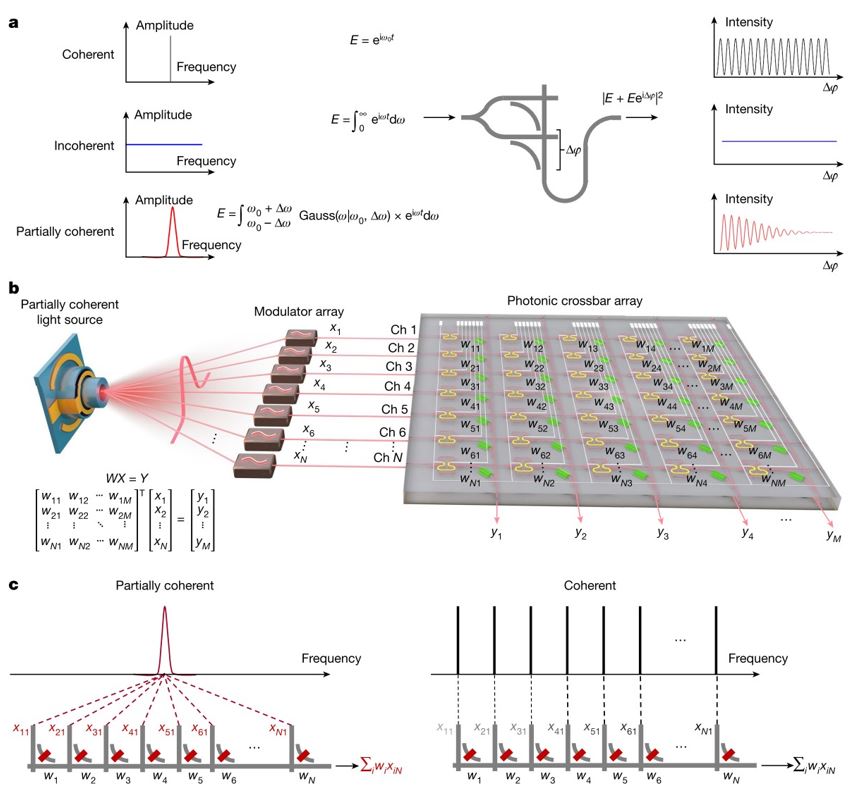|
— 資料提供:影像顯示科技知識平台 (DTKP, Display Technology Knowledge Platform) —
— 整理:林晃巖教授、郭權鋒 —
低同調光增強光子計算
同調光對於光子計算的應用相當廣泛,例如光達(Laser Imaging Detection And Ranging , LIDAR)、長距離光通信和光學同調斷層掃描(Optical Coherence Tomography, OCT)。同調光還可用於光子計算,因為其相位一致性確保了穩定和可預測的計算結果。然而,這需要透過整合型熱相移器(thermal phase shifters)精確控制光的相位,這不僅增加了功耗,還需滿足對溫度和頻率的穩定性需求。
藉由摻鉺光纖放大器(Erbium-doped fiber amplifier, EDFA)的濾波產生低同調光,均勻分配至N個輸入通道,每個通道的振幅進行調變以形成N個輸入向量單元(如圖一)。該輸入向量接著被傳送至具有加權單元的晶片以執行矩陣計算。相比之下,同調系統需要波長多工技術,要求N個獨立的光學頻段來實現同樣的N個向量單元,並避免不必要的干擾。因此,非同調方法能夠提高平行化程度,因為在單一頻段內可以同時執行比同調系統多N倍的運算。
|

|
|
圖一、部分同調增強平行光子計算的概念。(a) 當使用同調光、非同調光或部分同調光源時,在單一計算單位單元格的乘法與加法操作中,隨著相位差 ∆φ 增加而產生的強度變動,Gauss(ω|ω0,∆φ) 表示以平均值ω0和標準差∆ω的高斯分佈。(b) 使用部分同調光進行平行光子計算的工作原理。(c) N倍的平行化增強,N為輸入向量的維度。
|
晶片上的加權元件可以是任何能進行振幅調變的光子元件。作者在兩種情境下展示了該方法的應用。在第一個示例中,他們使用一個含有相變材料(phase-change materials, Ge2Sb2Te5和氧化銦錫堆疊)的整合電路,實現具備3 x 3張量核心的平行卷積處理。此架構能以92%的準確度對帕金森氏症患者的步態(gait)進行分類。在第二個示例中,作者實現了一個由比利時校際微電子研究中心(Inter-university Microelectronic Centre, IMEC)製作的矽基平台卷積處理器,並整合光檢測器。該處理器的運算速度最高可達每秒0.108兆次運算(TOPS),並以92.4%的準確度分類數據集(Modified National Institute of Standards and Technology database, MINST)(如圖二)。
|

|
|
圖二、MNIST手寫數位資料集的高速卷積處理。(a) 9×3光子電致光吸收調變器 (Electro-absorption modulator, EAM) 張量核心的照片。輸入光源為8.0 nm帶寬的部分同調光。尺度為100 µm。(b) 連接的光子EAM張量核心的模組照片,藍色框表示(a)中所示區域。(c) 使用Sobel Gx和Sobel Gy 濾波器進行數字“0”的邊緣檢測。(d)(e) 使用部分同調系統進行卷積的準確性,分別為不進行平均處理(d)和四點平均處理(e)。在(d)和(e)中共比較了100,000組預期和測量結果。插圖顯示了歸一化誤差的高斯分佈。(f) CNN架構。(g) CNN分類結果的比較。
|
此策略透過減少系統需求(通常包括昂貴的高性能雷射),有望實現更經濟且節能的光子計算。透過提供這些替代方案,該方案可降低光子計算架構發展時的經費支出和能耗需求。
|
參考資料:
|
Pitruzzello, G. "Low-coherence light enhances photonic computing," Nat Photon 18, 1009 (2024)
https://doi.org/10.1038/s41566-024-01536-6
DOI:10.1038/s41566-024-01536-6
|
|
參考文獻:
|
Dong, B., Brückerhoff-Plückelmann, F., Meyer, L. et al. "Partial coherence enhances parallelized photonic computing," Nature 632, 55-62 (2024)
https://doi.org/10.1038/s41586-024-07590-y
DOI:10.1038/s41586-024-07590-y
|
|